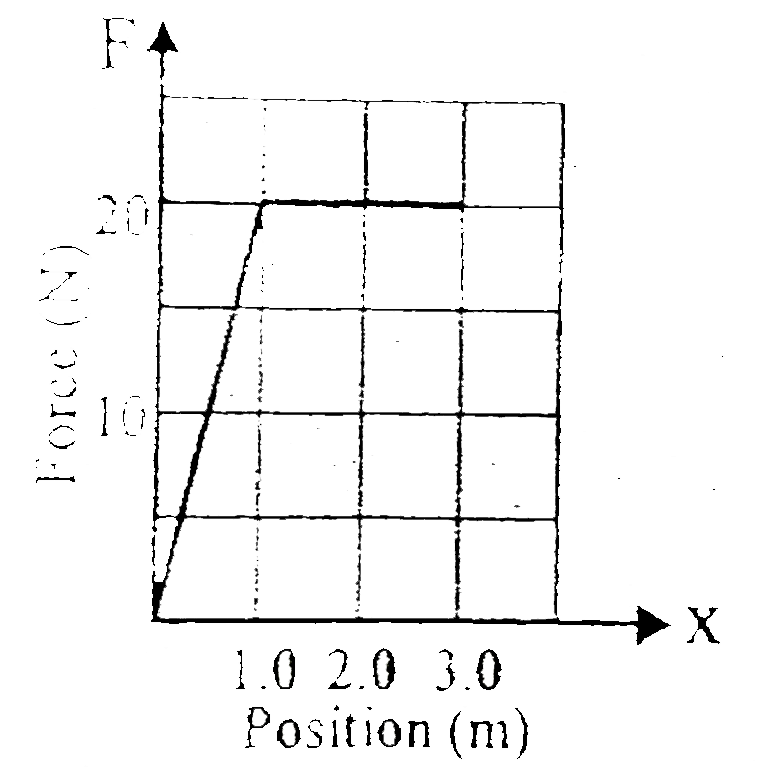A single conservative force acting on a particle varies as →F=(−Ax+Bx2)ˆiN, where A and B are constants and x is in meters. (a) Calculate the potential energy function U(x) associated with this force, taking U=0 at x=0. (b) Find the change in potential energy and the change in kinetic energy of the system as the particles moves from x=2.00m to x=3.00m.
To solve the problem step by step, we will break it down into two parts as per the question.
Part (a): Calculate the potential energy function U(x)
1. Given Force: The conservative force acting on the particle is given by:
→F=(−Ax+Bx2)^i N
where A and B are constants.
2. Relation between Force and Potential Energy: The relationship between force and potential energy is given by:
→F=−dUdx
This implies:
dU=−Fdx
3. Substituting the Force: Substitute the expression for the force into the equation:
dU=−(−Ax+Bx2)dx=(Ax−Bx2)dx
4. Integrating to Find U(x): Integrate both sides to find the potential energy function U(x):
U(x)=∫(Ax−Bx2)dx
Performing the integration:
U(x)=Ax22−Bx33+C
5. Applying the Condition U(0) = 0: Since we are given that U=0 at x=0:
U(0)=A(0)22−B(0)33+C=0⟹C=0
Thus, the potential energy function is:
U(x)=Ax22−Bx33
Part (b): Find the change in potential energy and change in kinetic energy
1. Calculate U at x = 2 m:
U(2)=A(2)22−B(2)33=4A2−8B3=2A−8B3
2. Calculate U at x = 3 m:
U(3)=A(3)22−B(3)33=9A2−27B3=9A2−9B
3. Change in Potential Energy (ΔU):
ΔU=U(3)−U(2)
Substituting the values we found:
ΔU=(9A2−9B)−(2A−8B3)
Simplifying this:
ΔU=9A2−9B−2A+8B3
To combine these terms, convert 2A and 9B to fractions with a common denominator:
ΔU=9A2−4A2+(−9B+8B3)
ΔU=5A2+(−27B3+8B3)=5A2−19B3
4. Change in Kinetic Energy (ΔK): The work-energy principle states:
ΔK=−ΔU
Thus:
ΔK=−(5A2−19B3)=−5A2+19B3
Final Answers:
- Potential Energy Function:
U(x)=Ax22−Bx33
- Change in Potential Energy:
ΔU=5A2−19B3
- Change in Kinetic Energy:
ΔK=−5A2+19B3
→F=(−Ax+Bx2)^i N
where A and B are constants.
→F=−dUdx
This implies:
dU=−Fdx
dU=−(−Ax+Bx2)dx=(Ax−Bx2)dx
U(x)=∫(Ax−Bx2)dx
Performing the integration:
U(x)=Ax22−Bx33+C
U(0)=A(0)22−B(0)33+C=0⟹C=0
Thus, the potential energy function is:
U(x)=Ax22−Bx33
U(2)=A(2)22−B(2)33=4A2−8B3=2A−8B3
U(3)=A(3)22−B(3)33=9A2−27B3=9A2−9B
ΔU=U(3)−U(2)
Substituting the values we found:
ΔU=(9A2−9B)−(2A−8B3)
Simplifying this:
ΔU=9A2−9B−2A+8B3
To combine these terms, convert 2A and 9B to fractions with a common denominator:
ΔU=9A2−4A2+(−9B+8B3)
ΔU=5A2+(−27B3+8B3)=5A2−19B3
ΔK=−ΔU
Thus:
ΔK=−(5A2−19B3)=−5A2+19B3
- Potential Energy Function:
U(x)=Ax22−Bx33
- Change in Potential Energy:
ΔU=5A2−19B3
- Change in Kinetic Energy:
ΔK=−5A2+19B3
Topper's Solved these Questions
- WORK, POWER & ENERGYBook:CENGAGE PHYSICS ENGLISHChapter:WORK, POWER & ENERGYExercise:Exercise 8.3
Explore 26 Videos
- WORK, POWER & ENERGYBook:CENGAGE PHYSICS ENGLISHChapter:WORK, POWER & ENERGYExercise:Exercise 8.4
Explore 16 Videos
- WORK, POWER & ENERGYBook:CENGAGE PHYSICS ENGLISHChapter:WORK, POWER & ENERGYExercise:Exercise 8.1
Explore 25 Videos
- VECTORSBook:CENGAGE PHYSICS ENGLISHChapter:VECTORSExercise:Exercise Multiple Correct
Explore 5 Videos
Similar Questions
The potential energy function associated with the force →F=4xyˆi+2x2ˆj is
View SolutionThe graph below shows how the force on a mass depends on the position of the mass. What is the change in the kinetic energy of the mass as it moves from x=0.0m to x=3.0 m ?

View SolutionA particle free to move along x-axis is acted upon by a force F=−ax+bx2whrteaandbarepositiveconstants., the correct variation of potential energy function U(x) is best represented by.
View SolutionThe potential energy of configuration changes in x and y directions as U=kxy, where k is a positive constant. Find the force acting on the particle of the system as the function of x and y.
View SolutionThe potential energy function of a particle is given by U(r)=A2r2−B3r, where A and B are constant and r is the radial distance from the centre of the force. Choose the correct option (s)
View SolutionThe potential energy for a conservative force system is given by U=ax2−bx. Where a and b are constants find out (a) The expression of force (b) Potential energy at equilibrium.
View SolutionThe potential energy for a conservative force system is given by U=ax2−bx. Where a and b are constants find out (a) The expression of force (b) Potential energy at equilibrium.
View SolutionOn a particle placed at origin a variable force F=−ax(where a is a positive constant) is applied. If U(0)=0, the graph between potential energy of particle U(x) and x is best represented by:-
View SolutionThe potential energy of a particle oscillating along x-axis is given as
U=20+(x−2)2
Here, U is in joules and x in meters. Total mechanical energy of the particle is 36J.
(a) State whether the motion of the particle is simple harmonic or not.
(b) Find the mean position.
(c) Find the maximum kinetic energy of the particle.
View SolutionA potential energy function for a two-dimensional force is the form U=3x2y−7x. Find the force that acts at the point (x,y).
View Solution
